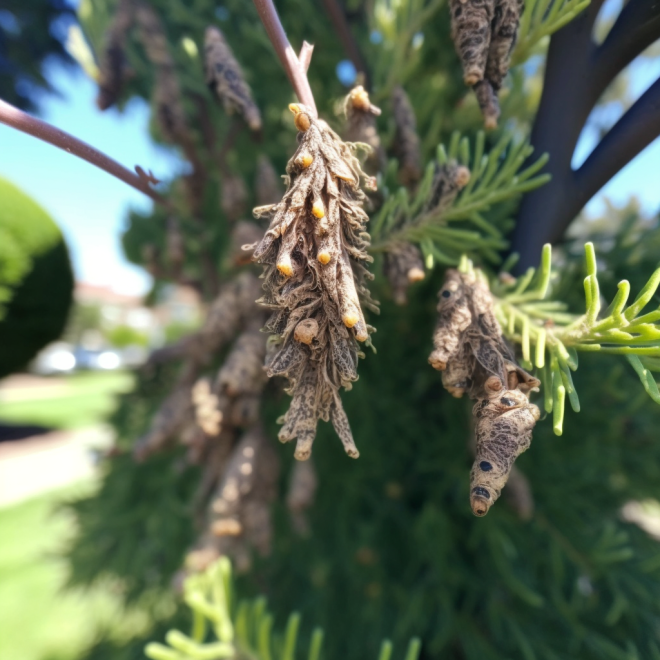Bagworms can wreak havoc on the trees and shrubs in your San Diego outdoor space. These tiny caterpillars can cause significant harm if left unaddressed.
In this guide, we’ll dive into the details of bagworms, including their life cycle, common symptoms of infestation, and effective control and prevention methods. Our expert arborists will provide you with all the information you need to safeguard your trees and maintain a beautiful, healthy outdoor space.
How to Identify Bagworm Infestations on Your Trees and Shrubs
Before you can begin to effectively control and prevent bagworm infestations, it’s important to know how to identify them. Bagworms are small caterpillars that create protective bags or cases made of plant material, which they carry around as they feed on the leaves of trees and shrubs.
One of the easiest ways to spot bagworms is to look for these cases hanging from the branches of your trees and shrubs. These cases can range in size from small and inconspicuous to several inches long and very noticeable.
Another sign of bagworm infestation is defoliation or the loss of leaves on your trees and shrubs. If you notice that your trees or shrubs are losing leaves or have bare branches, it’s possible that bagworms are to blame.
How Bagworm Infestations Can Damage Your Trees and Plants
Bagworms can cause serious damage to trees and plants if left untreated. These pests feed on the leaves of trees and shrubs, leading to defoliation, stunted growth, and even death of the plant.
The damage caused by bagworms is often more severe on smaller trees and shrubs, which have fewer leaves to begin with. In severe cases, bagworm infestations can lead to the death of the entire plant.
Identifying and treating bagworm infestations as soon as possible is important to prevent long-term damage to your trees and plants.
Preventing and Controlling Bagworm Infestations
Preventing and controlling bagworm infestations in your outdoor space is essential to maintaining healthy and beautiful trees and shrubs. Here are some effective prevention and control methods to consider:
- Manual Removal: If you spot bagworms early on, you can remove them manually by picking them off your trees and shrubs. Be sure to dispose of them in a sealed bag to prevent their spread.
- Pruning: Regularly pruning your trees and shrubs can help prevent bagworm infestations. Cut off any infected branches and dispose of them properly.
- Insecticides: Insecticides can be an effective way to control bagworms. Be sure to choose an insecticide that is labeled for use on bagworms and follow the instructions carefully.
- Natural Predators: Encouraging the presence of natural predators, such as birds and parasitic wasps, can help control bagworm populations.
By taking these preventative measures and acting quickly when an infestation is spotted, you can effectively control and prevent the spread of bagworms in your outdoor space.
Protect Your Trees from Bagworms Today
Bagworms can be a serious threat to the health and beauty of your outdoor space. By understanding their life cycle, symptoms of infestation, and effective prevention and control methods, you can protect your trees and shrubs and maintain a thriving landscape.
If you suspect a bagworm infestation, don’t hesitate to contact our expert arborists for professional treatment options. Our team at Pope Tree Service is dedicated to helping you keep your outdoor space healthy and beautiful for years to come.

